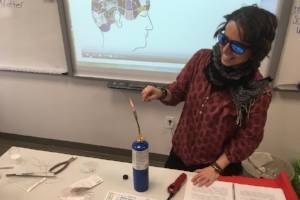Krista Carlson Shares Glass Science and Art with Incarcerated Populations
 My friend took a sip of his coffee and then smiled. “You would really like this program.
You need to apply for this program.” Looking up the program online, I learned that
STEMAP participants focused on designing content for segments of the population not
typically drawn to science or for people who have limited access to educational materials.
I promptly proceeded to apply and was excited about the prospect of designing more
engaging activities for the public.
My friend took a sip of his coffee and then smiled. “You would really like this program.
You need to apply for this program.” Looking up the program online, I learned that
STEMAP participants focused on designing content for segments of the population not
typically drawn to science or for people who have limited access to educational materials.
I promptly proceeded to apply and was excited about the prospect of designing more
engaging activities for the public.
While attending STEMAP workshops conducted at the beginning of the program, I envisioned and wrote a plan for my public engagement activity: combining glass science and movement. Over the next few weeks, it became clear to me that I needed to pivot and focus my efforts on another project. After many discussions with the STEMAP leaders, I decided to focus my efforts on creating content for STEMAP’s partner program, INSPIRE (Initiative to bring Science Programs to the Incarcerated in Utah). For the remainder of the program, I shared the connection between science and art in glass at the Utah State Prison, Salt Lake County Jail, and several juvenile detention centers. The invaluable guidance I received from the STEMAP team led to the successful creation of content for this population and to gaining access to these controlled facilities.
Upon completion of the formal mentorship program, I realized I did not want to stop participating in the engagement activities. The spirited dialogs I had with people in these controlled facilities were thought-provoking and enjoyable, and often led to my forgetting about the restrictive surroundings. The most significant personal change was my shift in attitude from “I’m giving back to the community” to recognizing that all people should have access to a good education. Access to a quality education, regardless of life situation or income, provides people with the opportunity to flourish and positively contribute to society.
During my time in the program, I learned more about the STEMAP team and their inspiration behind the creation of the program. The team is passionate about finding new ways to engage with “hard-to-reach” populations who cannot access science in traditional informal education institutions, such as science centers and museums. I have recently joined the team on their newest endeavor to develop a way to sustainably establish STEMAP at other universities. I am excited to work with these talented and driven individuals as we enhance STEMAP for the next generation of scientists.
About the Blog
Discussion channel for insightful chat about our events, news, and activities.
Categories
Featured Posts
Tag Cloud
- UoG (2)
- Guam (2)
- ethnobotany (1)
- environmental policy (1)
- student immersion (1)
- engineering (1)
- Virgin Islands (1)
- USVI (2)
- lionfish (1)
- children's home (1)
- conservation (1)
- marine ecology (1)
- youth (1)
- sustainability (2)
- Utah (1)
- Arizona (1)
- Nevada (1)
- southwest (1)
- virtual (1)
- project management (1)
- training (1)
- naturalist (1)
- forest (1)
- ecosystem (1)
- Puerto Rico (1)
- Spanish (1)
- library (1)
- Huntington's (1)
- medical science (1)
- Emmanuel Ngwoke (1)
